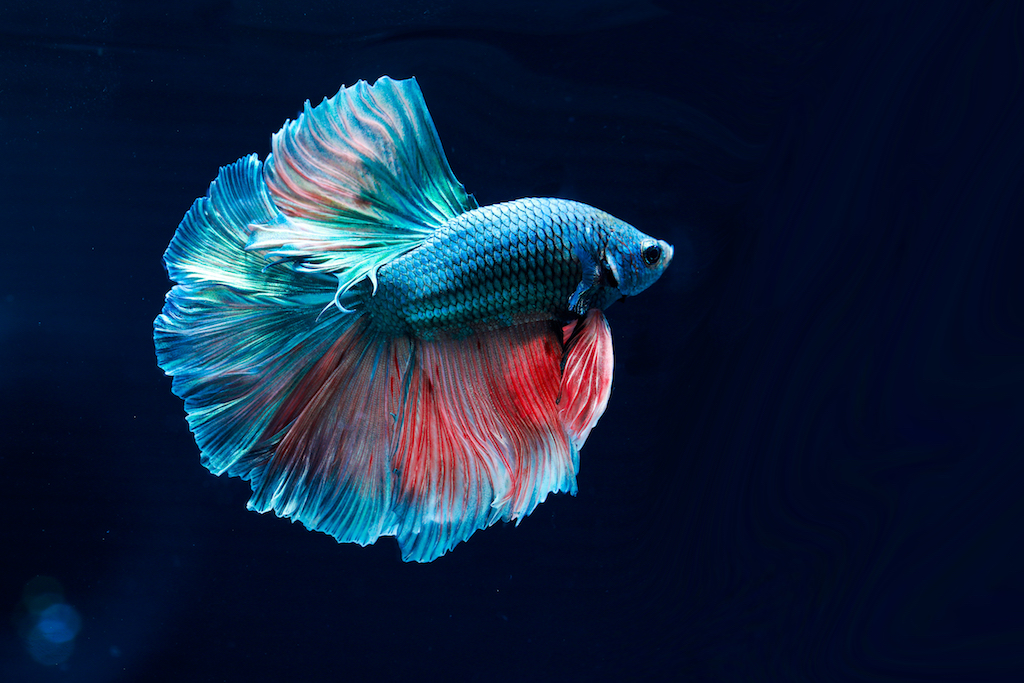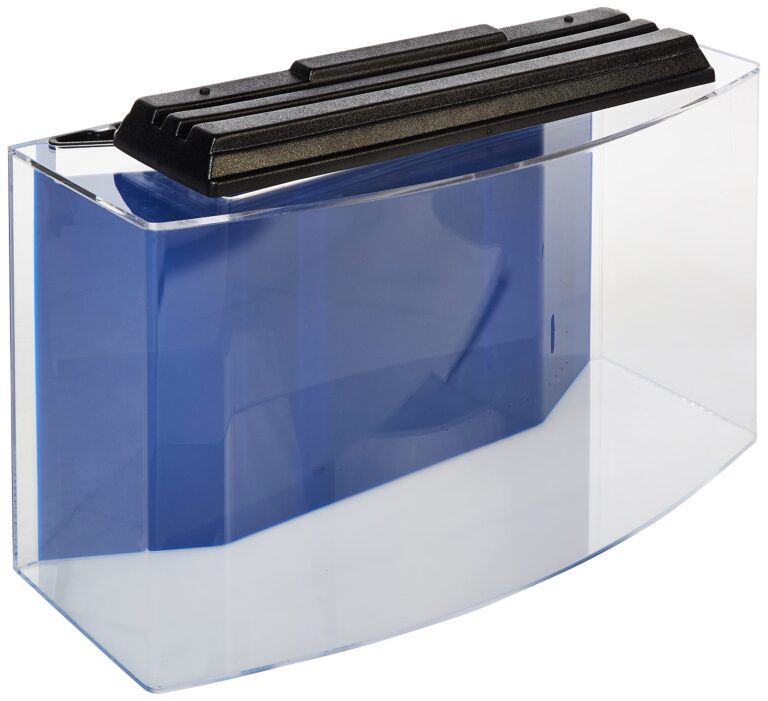Siamese Fighter Fish
The Siamese fighter fish is a tropical freshwater fish native to Southeast Asia. It is popular in the aquarium trade and known for its aggression towards other fish. The body of the Siamese fighter fish is elongated and compressed, with a long dorsal fin and a forked tail.
The head is small and blunt, with large eyes. The mouth is small and upturned, with sharp teeth. The body coloration is light brown to dark brown, with darker stripes running along the length of the body.
Males are typically more brightly colored than females.
Aquarium enthusiasts often choose Siamese fighter fish, or bettas, for their beauty and relatively easy care. Bettas are a type of labyrinth fish, meaning they have a special organ that allows them to breathe surface air. This makes them well-suited for living in small bowls or tanks without filtration or aeration systems.
However, it’s important to remember that bettas still need clean water and regular maintenance to stay healthy.While bettas are typically peaceful fish, they are also very territorial. Male bettas will often fight each other to the death if placed in the same tank.
For this reason, it’s best to keep only one male per tank. Females can usually be kept together, but there should be plenty of hiding places for them to escape aggression from the males.Bettas are omnivorous and will eat most types of pellets or flakes designed for tropical fish.
They also enjoy live food such as brine shrimp or bloodworms. A varied diet is important for keeping your betta healthy and vibrant.Siamese fighter fish make beautiful and low-maintenance pets that will add some excitement to your aquarium!
Siamese Fighting Fish for Sale
When it comes to purchasing a Siamese fighting fish, also known as a betta, there are many things you need to consider. Bettas are available for sale at most pet stores, however, not all stores carry healthy fish. Here are some tips on how to buy a healthy Siamese fighting fish:
-Look for a fish that has bright colors and is active. Avoid fish that look listless or have dull colors.
-Inspect thefish’s fins.
They should be long and flowing, without any tears or holes.
-Check thefish’s body for any signs of bumps or infections. The skin should be smooth with no irregularities.
-Ask the store employee when thefish were last fed and if they were given a vitamin supplement. A healthy diet is essential for bettas.If you follow these guidelines when purchasing a Siamese fighting fish, you will increase your chances of bringing home a healthy and happy betta!
Betta Fish
Betta fish are one of the most popular pets in the world. They are known for their beautiful colors and patterns, as well as their unique ability to “breathe” air through their labyrinthine organ. Bettas are native to Southeast Asia and can be found in a variety of habitats, from ponds and rivers to rice paddies and even drainage ditches!
Despite their popularity, bettas are often misunderstood pets. Many people believe that bettas are low-maintenance, easy-to-care-for fish, when in reality they require quite a bit of care and attention. In this blog post, we’ll dispel some common myths about betta care, and give you some tips on how to properly care for your new pet!
One of the most common misconceptions about bettas is that they can be kept in small bowls or containers with no filtration or aeration. This could not be further from the truth! Bettas are actually very sensitive to water quality, and need clean water to stay healthy.
A bowl or container that is too small will quickly become polluted with waste products and ammonia, which can lead to serious health problems for your fish. A minimum tank size for a single betta is 2.5 gallons (10 liters), but larger tanks are always better. It’s also important to ensure that your tank has adequate filtration and aeration – filter media such as activated carbon can help remove contaminants from the water, while an air stone or bubbler will help keep oxygen levels high.
Another common misconception about bettas is that they don’t need food other than what they can eat off of plant leaves. While it’s true that bettas are carnivores and prefer live foods such as bloodworms or brine shrimp, they still need a varied diet to stay healthy. A good quality pellet food should form the base of their diet, supplemented with occasional feedings of live or frozen foods.
It’s important not to overfeed your betta – only give them as much food as they can eat in two minutes twice per day.
Fighter Fish Price
Fighter Fish Price: How Much Does a Betta Cost?A betta, also known as a Siamese fighting fish, is a popular freshwater aquarium fish. Bettas are native to Southeast Asia and prefer warm water.
Male bettas are especially popular because of their long fins and vibrant colors. If you’re thinking about adding a betta to your home aquarium, you’re probably wondering how much they cost.Bettas are available for purchase at most pet stores that sell fish.
Prices can vary depending on the store, but typically range from $5-$30. The price will also depend on the specific type of betta you’re looking for. For example, fancy bettas with long fins and bright colors tend to be more expensive than regular bettas.
If you want to save money on a betta fish, you can always look for discounts at your local pet store or online. You can also find used tanks and other aquarium equipment at garage sales or online classifieds websites like Craigslist. With a little patience and effort, you should be able to find everything you need to set up a comfortable home for your new fighter fish friend!
Siamese Fighting Fish Care
The Siamese fighting fish, known to tropical fish hobbyists as the betta, is a beautiful and unique freshwater fish. Although they are often thought of as easy to care for because they can live in small spaces, bettas are actually quite delicate and require very specific water conditions and care. In this article, we’ll go over everything you need to know about caring for your Siamese fighting fish.
Bettas are native to the warm waters of Southeast Asia, so they prefer water that is around 78-80 degrees Fahrenheit. They also like their water to be slightly acidic with a pH between 6.5 and 7.0. If you don’t have a water testing kit, you can usually find out the pH of your tap water from your local municipality or utility company.
If your tap water doesn’t meet these parameters, you’ll need to either adjust it with chemicals (available at pet stores) or use bottled spring water. Whichever way you choose to do it, make sure that you slowly acclimate your betta to any new water by adding a little bit at a time over the course of an hour or so until his tank is filled with the new water. This process is called “acclimation” and it’s important because sudden changes in pH or temperature can shock and even kill Bettas.
Bettas also like a lot of hiding places in their tanks – think plants, rocks, caves, etc. They are naturally shy creatures and feel more secure when they have plenty of places to hide away from view if they get scared or stressed out. A good rule of thumb is one gallon per Betta plus some extra room for him to swim around freely; so a five-gallon tank would be ideal for housing one Betta fish.
And speaking of tanks… never house more than one Betta together unless you’re planning on breeding them! These guys are really territorial and will fight each other relentlessly if forced to share space – sometimes even resulting in death.
Chinese Fighter Fish
A Chinese fighter fish is a type of freshwater aquarium fish that is native to China. The Chinese fighter fish is a member of the genus Betta and the family Osphronemidae. The Chinese fighter fish is also known as the Siamese fighting fish, betta, or simply betta.
The Chinese fighter fish is found in Thailand, Laos, Cambodia, Vietnam, and southern China. In the wild, the Chinese fighter fish inhabits stagnant waters with little or no water flow such as ponds, ditches, and rice paddies.The Chinese fighter fish has an elongated body that is compressed laterally.
The head of the Chinese fighter fish is large and flat with a small mouth located at the tip of the snout. The eyes of the Chinese fighter fishes are situated on either side of the head just behind the gill covers. The dorsal fin and anal fins of theChinese fighterfish are long and pointed while the pectoral fins are short and round.
The pelvic fins are thread-like and located just behindthe ventral fins which are also thinand filamentous. The caudal peduncleof theChinese fighterfishis slenderand tapers to a pointy tail fin . AdultChinesefighterfishes typically grow to be about 2-3 inches (5-7 cm) long although some specimens have been known to reach lengths of 4 inches (10 cm).
The typical lifespanofaChinesefighterfishis2–4 yearsin captivity; however, wild specimens typically only live for about 6 months due to predationand other environmental factors . In captivity , proper care must be taken in orderto ensurethattheChinesefighterfishlives out its full potential life span . This includes providing clean water , a nutritious diet , appropriate tank mates , and regular vet checkups .
Fun Facts About Betta Fish
Betta fish are one of the most popular freshwater aquarium fish. They are known for their bright colors and beautiful fins. Bettas are also very easy to care for, making them a great choice for beginner fishkeepers.
Here are some fun facts about betta fish:-Bettas are native to Southeast Asia.
-They belong to the gourami family, which includes other popular aquarium fish like goldfish and koi.
-Bettas can breathe air using a special organ called the labyrinth. This allows them to survive in environments with low oxygen levels, like stagnant ponds or rice paddies.
-Bettas are carnivores and prefer live food, such as worms or brine shrimp.
However, they will also eat pellets or flakes designed specifically for bettas.
-Male bettas are very territorial and will often fight with each other if they are housed in the same tank. For this reason, it is best to keep only one male per tank.
Females can be kept together in groups, but they may also fight if not given enough space.
Betta Fish in the Wild
Betta fish are a beautiful and popular species of fish that are often kept as pets. They are native to Southeast Asia and can be found in slow-moving streams, ponds, and rice paddies. In the wild, bettas live in small groups and build nests out of floating plants.
The males are very territorial and will defend their nesting sites from other males.Bettas are relatively easy to care for and make great first pets for children or adults. They can be kept in bowls or aquariums with other peaceful fish species.
It is important to provide them with plenty of hiding places so they feel secure. Bettas are known for their ability to “jump” out of open tanks, so it is important to keep the lid on tight!If you’re thinking about adding a betta fish to your home, do some research on proper care first.
These beautiful creatures deserve a happy and healthy life!
Betta Fish Fight
Betta fish are beautiful creatures that many people enjoy keeping as pets. They are also known for their ability to fight, which has made them a popular choice for fish fighting competitions. While betta fish fighting is a controversial topic, there is no denying that it is a popular pastime in many parts of the world.
If you’re thinking about getting into betta fish fighting, there are a few things you should know. First, betta fish must be kept in separate tanks – they cannot be housed together. Second, when it comes time to fight, the fish are placed in a small arena where they can see each other but cannot touch.
Third, the goal of the fight is not to kill the other fish, but simply to force him to surrender by swimming away from the combat area. fourth, most fights only last a few minutes and end when onefish decides he’s had enough and swims away.While betta fish fighting may seem like a cruel sport to some, it’s important to remember that the fish do not appear to be suffering any lasting harm.
In fact, many owners say that their fishes become more active and seem happier after participating in a few fights. If you’re interested in giving betta fish fighting a try, be sure to do your research and find a reputable source for your supplies and information.

Credit: www.livescience.com
Are Siamese Fighting Fish Good Pets?
Siamese fighting fish – also known as bettas – are popular pets, but are they good for first-time fish owners? In this article, we’ll explore the pros and cons of keeping a betta fish as a pet, to help you decide if this is the right type of fish for you.Bettas are beautiful creatures, with long fins and vibrant colors.
They’re relatively easy to care for, and can live in small spaces like bowls or aquariums. Bettas are also relatively low-maintenance when it comes to feeding – they can go several days without food.However, there are some drawbacks to keeping bettas as pets.
First of all, they’re solitary creatures by nature, so they don’t do well in tanks with other fish. They’re also very territorial, and will often fight with other bettas (hence their nickname “fighting fish”). For these reasons, it’s important to research whether or not a betta is the right type of pet for you before making a purchase.
What Fish Can You Put With a Siamese Fighter?
If you’re considering adding a Siamese fighter fish to your aquarium, you might be wondering what other fish species are compatible with this popular freshwater tropical. In general, Siamese fighters are peaceful by nature and can be kept with most other small to medium-sized freshwater fish that occupy different levels of the water column. However, there are a few things to keep in mind when choosing tank mates for your Siamese fighter.
First, avoid mixing Siamese fighters with other aggressive or territorial fish species that could bully or harass them. Second, since Siamese fighters prefer warm water temperatures (between 76-82 degrees Fahrenheit), choose tank mates that also thrive in similar conditions. And lastly, consider the adult size of your potential tank mates when selecting them for your aquarium – you’ll want to avoid pairing up your Siamese fighter with much larger fish that could outgrow and overwhelm them.
With those guidelines in mind, here are some good options for compatible freshwater fish to keep with Siamese fighters: neon tetras, harlequin rasboras, kuhli loaches, dwarf gouramis, pearl gouramis, angelfish and clown loaches.
Are Siamese Fighting Fish Good for Beginners?
If you’re thinking about getting a Siamese fighting fish, or “bettafish” as they’re sometimes called, you might be wondering if they’re a good choice for beginners. The answer is yes and no.On the one hand, bettas are relatively easy to care for and don’t require a lot of space, making them ideal for first-time fishkeepers.
They’re also very attractive fish, with bright colors and long fins that come in a variety of shapes and sizes.On the other hand, bettas can be aggressive towards each other (hence their name), so if you’re planning on keeping more than one fish, you’ll need to provide them with plenty of hiding places and put them in separate tanks. They also have a reputation for being finicky eaters, so you may need to experiment with different types of food before finding something they’ll eat consistently.
Overall, bettas make great pets for both experienced fishkeepers and beginners alike. Just be sure to do your research before bringing one home!
How Many Siamese Fighting Fish Can You Have in a Tank?
If you’re considering adding a Siamese fighting fish (Betta splendens) to your home aquarium, you might be wondering how many of these feisty fish you can keep in one tank. The answer isn’t as simple as “one per gallon” or “two per ten gallons,” as with many other freshwater fish species. Here’s what you need to know about keeping multiple Bettas in the same aquarium.
The number of Siamese fighting fish that can be kept in the same tank depends on several factors, including:-The size of the tank
-The number and size of hiding places or shelters
-The aggressiveness of the individual fish
-Whether the fish are male or female (males are much more aggressive than females)In general, it’s best to keep only one Betta per tank unless you have a very large aquarium (over 50 gallons) and can provide plenty of hiding places for the fish.
If you do choose to keep multiple Bettas together, it’s important to carefully observe their behavior and be prepared to separate them if necessary.
Betta / Siamese Fighting Fish Care, Info and Advice
Conclusion
If you’ve ever seen a Siamese fighting fish, also known as a betta, you might have been struck by their beauty. But these fish are more than just pretty faces; they’re also fierce fighters. In the wild, Siamese fighting fish are often found in rice paddies and stagnant pools in Thailand, where they use their long fins to fend off predators and rivals.
In captivity, Siamese fighting fish are kept in small tanks or bowls and pitted against each other in fights. These fights can be deadly, and even if they’re not, the fishes’ fins often get ripped to shreds. Some people see this as cruel and unnecessary, but others find it fascinating to watch two creatures battling it out.
If you’re thinking of getting a Siamese fighting fish, be prepared to give them a lot of attention. They need clean water and plenty of space to swim around. And if you do decide to put them in a tank with other fishes, make sure those tankmates are peaceful!






